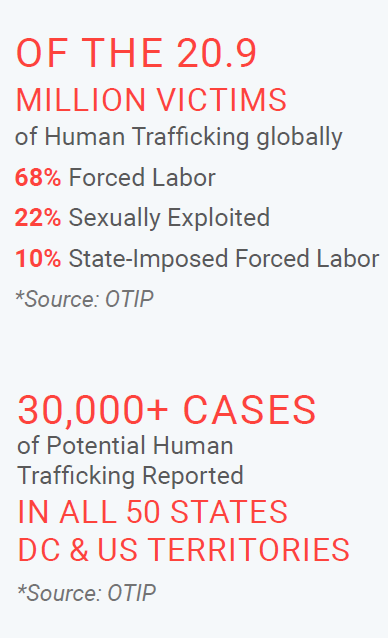How REI Systems delivered digital services to increase the efficiency of victim identification, expedite victims’ services, and strengthen analytics for anti-trafficking programs.
Challenge

Since 2018, the incidence of trafficking has dramatically increased. OTIP experienced a commensurate surge in requests from victims for benefit eligibility determinations. This surge in demand, combined with a cumbersome process model across several federal agencies (Department of Homeland Security, Department of Justice, the Department of Housing and Urban Development, and the Department of Labor), led OTIP to modernize its IT— specifically the database it used to manage information and services for victims of trafficking.
The business processes used within OTIP to collect and manage human trafficking data and documentation involved email submissions of case documentation, manual case data entry, digital signing, manual printing and scanning of forms, and other ad hoc procedures, which lead to delays in case processing. The process was slow, laborious to maintain the privacy and security of victim information, required lots of manual processing, and was burdensome for both OTIP and the victims.
REI Solution
The joint REI Systems and ACF team developed a modern Shepherd Case Management System (S-CMS). The design allowed for lower costs, better security, improved collaboration, and easier user access. S-CMS consists of a web portal for case submission and tracking, case management and workflows, and email notifications. At the time, S-CMS was the most technically complex application deployed at ACF. S-CMS leverages modern technologies and software development approaches:
Agile Delivery Framework
The team used REI’s Agile Delivery Framework approach to develop the software and achieve collaboration and reconciliation of requirements and concerns from multiple federal agencies. The Agile approach to process development and program management allowed each collaborating agency to gradually reconcile conflicts with other agencies to ensure the success of the collaboration. The Agile approach to process development and program management left each participating agency willing to accept the common certification of the victim – so that victims no longer needed to revisit and repeatedly prove their victimization to each different agency.
Human-Centered Design
The team leveraged an Agile user-centric design. The new business processes were designed in collaboration with OTIP to streamline and automate processes, reduce inefficiencies, and reflect the future vision of the program. The design team took into consideration the users of the application and the victims seeking help. They wanted to help the victims receive faster services and benefits free from fear. This focus led to additional security and authentication decisions to protect the privacy of victims and avoid risks that they will be re-discovered by traffickers.
Microservices Architecture
S-CMS uses a microservices-based shared cloud platform, making it easier for partner agencies to collaborate. The case management portion of the application is broken down into three major microservices – Shepherd Request, Shepherd Review, and Shepherd Case. S-CMS was designed as a domain entity with an infinite lifespan and can be updated at any point as laws and regulations change. This domain is broken into three major features and supports multiple roles with various data access privileges, multi-level workflow, and time-based tasks.
Cloud Hosting and Security
S-CMS is hosted on a FedRAMP AWS cloud infrastructure that leverages EC2, S3, ALB, and RDS cloud services to provide on-demand scalability, flexibility, and storage. Cloud hosting was essential to allow multiple agencies, grantees, advocates, and social workers to use the system securely from diverse locations. The security features are imperative to prevent traffickers and other bad actors from accessing victims’ personally identifiable information. Finally, the automation allows OTIP and its partners to serve victims much more quickly – in less than half the number of days previously required, and to serve increased numbers of victims with no
increase in staffing.
CD/CI Pipeline
REI and ACF’s Information Technology Team collaborated to implement an automated CI/CD development environment, with build and release pipelines automated by AWS Cloud Formation and Cloud Deploy and automated testing using xUnit and JEST for angular. This automated development environment made it possible to deploy S-CMS allowing multiple agencies to observe it, provide feedback to developers, and reconcile potential conflicts with each other.
Partner Impact
S-CMS was a game-changer for OTIP. The system replaced a manual process with digital services to increase the efficiency of victim identification, expedite victims’ access to services, and strengthen OTIP data management and analytics for anti-trafficking programs. The most notable program benefits of S-CMS include
the following:
- Serving victims of human trafficking 50% faster
- Saving 20,000 hours of labor for every 2,000 cases
- Simplifying federal agency collaboration for better citizen services
- Improving victim privacy and security
“Previously, we didn’t have the capacity to serve all of the victims [who came forward to us]. With S-CMS, now we do.…we could not have done this without REI Systems.”
— Katherine Chon, Director, Office on Trafficking in Persons




